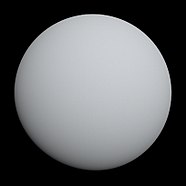Kepler-440b
| Discovery | |
|---|---|
| Discovery site | Kepler Space Observatory |
| Discovery date | 2015[2] |
Detection method | Transit |
| Orbital characteristics | |
Semi-major axis | 0.24200 AU (36,203,000 km) |
| Eccentricity | >0.340 |
Orbital period | 101.11141000 d |
| Inclination | 89.930 |
| Star | |
| Physical characteristics | |
Mean radius | 1.860 REarth |
| Temperature | 273 K (0 °C; 32 °F).[3] |
Kepler-440b (also known by its Kepler Object of Interest designation KOI-4087.01) is a confirmed super-Earth exoplanet orbiting within the habitable zone of , about 850 light-years (261 pc) from Earth.[1] The planet was discovered by NASA's Kepler spacecraft using the transit method, in which the dimming effect that a planet causes as it crosses in front of its star is measured. NASA announced the confirmation of the exoplanet on 6 January 2015.[4]
Confirmed exoplanet[]
Kepler-440b is a super-Earth with a radius 1.86 times that of Earth. The planet orbits Kepler-440 once every 101.1 days.[1]
Habitability[]
The planet was announced as being located within the habitable zone of Kepler-440, a region where liquid water could exist on the surface of the planet.[1]
| Notable Exoplanets – Kepler Space Telescope |
|---|

(Kepler-62e, Kepler-62f, Kepler-186f, Kepler-296e, Kepler-296f, Kepler-438b, Kepler-440b, Kepler-442b) (Kepler Space Telescope; 6 January 2015).[4] |
| Earth | Kepler-440b |
|---|---|

|

|
See also[]
References[]
- ^ a b c d Torres, Guillermo; Kipping, David M.; Fressin, Francois; Caldwell, Douglas A.; Twicken, Joseph D.; Ballard, Sarah; Batalha, Natalie M.; Bryson, Stephen T.; Ciardi, David R.; Henze, Christopher E.; Howell, Steve B.; Isaacson, Howard T.; Jenkins, Jon M.; Muirhead, Philip S.; Newton, Elisabeth R.; Petigura, Erik A.; Barclay, Thomas; Borucki, William J.; Crepp, Justin R.; Everett, Mark E.; Horch, Elliott P.; Howard, Andrew W.; Kolbl, Rea; Marcy, Geoffrey W.; McCauliff, Sean; Quintana, Elisa V. (2015). "Validation of Twelve Small Kepler Transiting Planets in the Habitable Zone". The Astrophysical Journal. 800 (2): 99. arXiv:1501.01101. Bibcode:2015ApJ...800...99T. doi:10.1088/0004-637X/800/2/99. S2CID 8512655.
- ^ Staff (2015). "Planet Kepler-440 b". The Extrasolar Planets Encyclopaedia. Retrieved 11 January 2015.
- ^ "HEC: Data of Potential Habitable Worlds".
- ^ a b Clavin, Whitney; Chou, Felicia; Johnson, Michele (6 January 2015). "NASA's Kepler Marks 1,000th Exoplanet Discovery, Uncovers More Small Worlds in Habitable Zones". NASA. Retrieved 6 January 2015.
External links[]
- NASA – Mission overview.
- NASA – Kepler Discoveries – Summary Table.
- NASA – Kepler-440b at The NASA Exoplanet Archive.
- NASA – Kepler-440b at The Extrasolar Planets Encyclopaedia.
- Habitable Exolanets Catalog at UPR-Arecibo.
Coordinates: ![]() 19h 01m 23.99s, +41° 27′ 07.94″
19h 01m 23.99s, +41° 27′ 07.94″
- Exoplanets discovered by the Kepler space telescope
- Exoplanets discovered in 2015
- Super-Earths in the habitable zone
- Transiting exoplanets
- Lyra (constellation)



